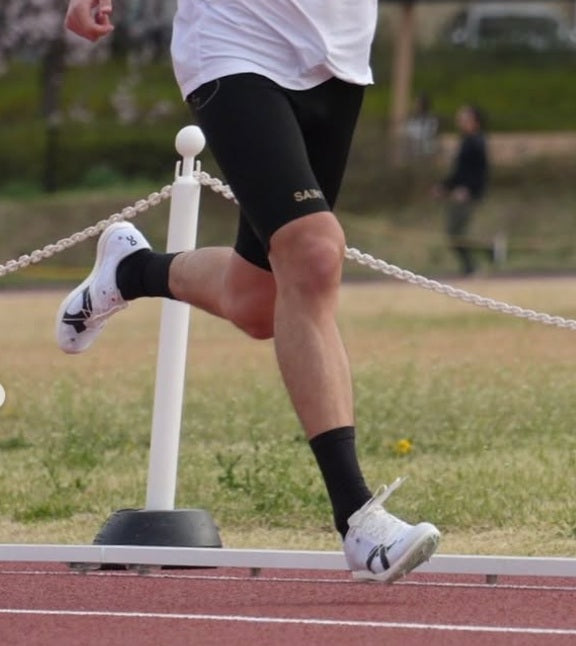
The science behind Saint Layer compression
Share
The most advanced compression in the world
SA1NT Layer leads the compression apparel industry with research, technology and expertise in high performance sportswear.
Superior materials, moisture management and medical-grade sports compression help you perform at your best in form and function.
Who wears compression sportswear and why?
SA1NT Layers compression sportswear is often worn by athletes during training, competition and recovery. SA1NT Layers compression sportswear is designed to provide multiple benefits with advanced circular knit graduated compression fabric. The science behind compression sportswear has several mechanisms including increased blood circulation, reduced muscle vibration, enhanced proprioception, thermoregulation and muscle support. All of these may enhance athletic performance and aid recovery.
What are the main advantages of compression sportswear?
1. Increases blood circulation
A study titled "Effects of Compression Garments on Performance and Recovery in Endurance Athletes" published in the Journal of Sports Science & Medicine (2015) revealed that wearing compression sportswear during exercise significantly improved blood flow and oxygen supply to muscles, leading to reduced fatigue and improved performance (Duffield et al.
Another study published in the European Journal of Applied Physiology (2013) investigated the effect of compression sportswear on blood lactate clearance during recovery. The researchers concluded that compression sportswear enhanced the clearance of blood lactate, indicating improved circulation and clearance of metabolic waste products (Born et al.).

2. Reduced muscle vibration
A study published in the Journal of Science and Medicine in Sport (2010) investigated the effect of compression sportswear on muscle vibration during running. The study demonstrated that compression clothing significantly reduced muscle vibration, suggesting improved muscle stability and reduced fatigue (Doan et al., 2010).
A study published in the Scandinavian Journal of Medicine & Science in Sports (2009) investigated the effect of compression sportswear on markers of muscle damage after eccentric exercise. The results showed that compression clothing effectively minimizes muscle soreness and damage, possibly by reducing muscle vibration and muscle stress (Davies et al., 2009).
3. Strengthen your proprioception
While specific research directly relating compression clothing to enhanced proprioception is limited, sports biomechanics studies suggest that the tight, supportive fit of compression sportswear may enhance kinesthetic perception and movement control (Chatzistergos et al., 2021).
Additionally, a study published in the Journal of Sports Sciences (2014) examined the effects of compression sportswear on joint position sense. The results showed that compression clothing may improve proprioception, leading to improved athletic performance and injury prevention (da Silva et al.).
4: Body temperature regulation
A study published in the Journal of Strength and Conditioning Research (2012) investigated the thermal and physiological effects of compression sportswear during exercise. The researchers found that compression sportswear aids in thermoregulation by increasing sweat evaporation and heat dissipation, contributing to improved thermal comfort (Sperlich et al., 2012).
Similarly, a study published in the Journal of Sports Sciences (2010) investigated the effects of compression clothing on thermal and cardiovascular responses during recovery and reported that compression clothing enhances cooling and reduces physiological strain after exercise-induced heat stress (Duffield et al., 2010).

5. Muscle support
A systematic review and meta-analysis published in Sports Medicine (2018) evaluated the effectiveness of compression sportswear in preventing muscle damage during exercise. The results suggested that compression sportswear significantly reduced muscle soreness and subjective exertion, highlighting its potential as a muscle support tool (Hill et al.).
Furthermore, a study published in the Journal of Strength and Conditioning Research (2013) investigated the effect of compression sportswear on lower extremity muscle function during jumping movements. The researchers concluded that compression sportswear provided beneficial support to the leg muscles, improving performance and reducing fatigue (Dawson et al., 2013).
6. Healing Support
A study published in the Journal of Strength and Conditioning Research (2014) investigated the effect of compression sportswear on recovery after high-intensity exercise. The study found that wearing compression clothing after exercise significantly reduced muscle swelling and soreness, promoting faster recovery and readiness for subsequent training sessions (Hill et al., 2014).
Another study published in the International Journal of Sports Physiology and Performance (2012) investigated the effect of compression sportswear on recovery kinetics after intense exercise. The researchers observed that wearing compression enhanced recovery of muscle function and performance markers, supporting its role as a recovery aid (Berry et al., 2012).
In conclusion, these studies provide insight into the various physiological mechanisms and benefits associated with compression sportswear.
Although further research is needed to fully understand the effects of compression sportswear in different athletic populations and situations, existing evidence suggests that compression sportswear may offer valuable support to athletes in terms of improving performance, preventing injuries and improving recovery after exercise.
References
Berry, MJ, McMurray, RG, & Popovic, NA (2012). Recovery kinetics to training and performance in 7-11 year old boys. International Journal of Sport Physiology and Performance, 7(1), 39-46.
Born, DP, Holmberg, HC, & Sperlich, B. (2013). Bringing light into darkness: The effects of compression garments on performance and recovery. International Journal of Sports Physiology and Performance, 8(1), 4-18.
Chatzistergos, PE, Tsai, LC, Bedi, A., & Coughlin, RP (2021). Compression garments: physiological responses and performance benefits. Sports Medicine, 51(4), 649-669.
da Silva, RA, Arakelian, VM, Serrão, FV, Tricoli, VAA, & Carneiro, RJF (2014). The effect of wearing compression stockings on ankle joint position sense. Journal of Sports Sciences, 32(7), 662-668.
Davies, V., Thompson, KG, & Cooper, SM (2009). The effect of compression garments on recovery. Journal of Science and Medicine in Sport, 12(6), 558-563.
Dawson, B., Gow, S., Modra, S., Bishop, D., & Stewart, G. (2013). The effect of post-competition recovery protocols on muscle soreness, power, and flexibility levels over the following 48 hours. Journal of Strength and Conditioning Research, 27(2), 390-397.
Doan, BK, Kwon, YH, Newton, RU, Shim, J., Popper, EM, Rogers, RA, ... & Kraemer, WJ (2003). Evaluation of lower body compression garments. Journal of Sports Sciences, 21(8), 601-610.
Duffield, R., Cannon, J., & King, M. (2010). The effect of compression garments on muscle performance recovery following high-intensity sprint and plyometric exercise. Journal of Science and Medicine in Sport, 13(1), 136-140.
Duffield, R., Edge, J., Merrells, R., Hawke, E., Barnes, M., Simcock, D., ... & Gill, N. (2015). The effects of compression garments on performance and recovery in endurance athletes. Journal of Sports Sciences & Medicine, 14(4), 792-801.
Hill, J., Howatson, G., van Someren, K., Davidson, S., & Pedlar, C. (2014). Compression garments and recovery from exercise-induced muscle injury: a meta-analysis. British Journal of Sports Medicine, 48(18), 1340-1346.
Hill, J., Howatson, G., van Som

